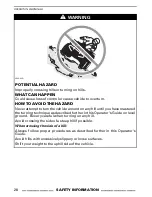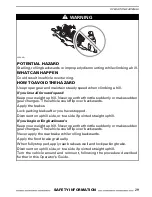
RIDING THE VEHICLE
To fully appreciate the pleasures and excitement of riding this vehicle, there are
some basic rules and tips that you MUST follow. Some may be new to you while
others may be common sense or obvious.
Please take the time to study this Operator's Guide and all on-product warning la-
bels as well as the
SAFETY VIDEO
that came with this vehicle. They more com-
pletely describe what you should know about this vehicle before riding it.
Whether you are a new user or an experienced rider, it is important for your person-
al safety that you know the controls and features of this vehicle. Equally important
is knowing how to properly ride.
Information in this Operator's Guide is limited. It is strongly recommended that
you obtain further information and training from your local authorities, ATV clubs,
a recognized ATV training organization or contact an authorized Can-Am dealer.
USA and Canada only:
to find out about available training course nearest you,
call the Specialty Vehicle Institute of America (SVIA) at 1 800 887-2887 or in
Canada, the Canada safety Council (CSC) at 1 613 739-1535 ext. 227.
The U.S. Consumer Product Safety Commission and all ATV manufacturers recom-
mends that no one under the age of 16 drives an ATV having an engine higher than
90 cc. For the child's safety, we strongly recommend you also follow and enforce
this recommendation. You are the sole judge of a rider's capability to understand
the risks and operate a vehicle safely.
Persons with cognitive or physical impairments or who are high risk takers have an
increased exposure to overturns or collisions which may result in injury including
death.
Not all vehicles are the same. Each has its own unique performance characteris-
tics, controls and features. Each will ride and handle differently.
Become completely familiar with the operational controls and the general opera-
tion of the vehicle before venturing into off road conditions. Practice driving in a
suitable area free of hazards and feel the response of each control. Drive at low
speeds. Higher speeds require greater experience, knowledge and suitable riding
conditions.
Riding conditions vary from place to place. Each is subject to weather conditions
which may radically change from time to time and from season to season.
Riding on sand is different than riding on snow or through forests or marshes.
Each location may require a greater degree of awareness and skill. Show good
judgement. Always proceed with caution. Please do not take any unnecessary
risks that could leave you stranded or possibly injured.
Never assume that the vehicle will go everywhere safely. Sudden changes in ter-
rain caused by holes, depressions, banks, softer or harder “ground” or other irreg-
ularities may cause the vehicle to topple or become unstable. To avoid this, slow
down and always observe the terrain ahead. If the vehicle does begin to topple or
tipover, the best advice is to immediately get off... AWAY from the direction of the
tipover!
38
_______
SAFETY INFORMATION
________
Summary of Contents for 2009 Renegade 500
Page 1: ......
Page 8: ...TABLE OF CONTENTS 6 _______________ ...
Page 9: ...SAFETY INFORMATION ________ SAFETY INFORMATION ________ 7 ...
Page 57: ...IMPORTANT ON PRODUCT LABELS vmo2008 014 001 LABEL 11 ________ SAFETY INFORMATION ________ 55 ...
Page 58: ...IMPORTANT ON PRODUCT LABELS 56 _______ SAFETY INFORMATION ________ ...
Page 59: ...VEHICLE INFORMATION _______________ 57 ...
Page 61: ...CONTROLS INSTRUMENTS EQUIPMENTS 11 6 vmo2008 005 009_b TYPICAL _______________ 59 ...
Page 82: ...VEHICLE TRANSPORTATION 80 ______________ ...
Page 83: ...MAINTENANCE INFORMATION _______________ 81 ...
Page 114: ...STORAGE AND PRESEASON PREPARATION 112 ______________ ...
Page 115: ...TECHNICAL INFORMATION ______________ 113 ...
Page 123: ...TROUBLESHOOTING ______________ 121 ...
Page 129: ...WARRANTY ______________ 127 ...
Page 146: ...CHANGE OF ADDRESS OWNERSHIP 144 ______________ ...
Page 148: ......
















































